
Our New Marine Protected Areas
Understanding our network of protection on the north coast
Our ocean is home to a vast array of marine life, ranging from microscopic plankton up to the largest animal on earth, the blue whale. As our understanding of the marine environment has broadened, and as we have seen the degradation and collapse of marine systems around the world, state and federal agencies have responded by protecting special areas of the coastal ocean in order to conserve habitat for this diversity of marine life. Marine protected areas (called MPAs) have existed for many years, as special resources are protected to create more sustainable marine ecosystems, functioning much like parks on land.
California recently completed a multi-year process to establish an new integrated network of MPAs along its 1100 mile coastline. The north coast region’s MPAs were formally established last year. For a complete look at the statewide network, regulations, and the enforcement plan, visit the California Department of Fish and Wildlife’s MPA webpage. Also, see CDFW’s MPA story by Mary Patyten.
The North Coast’s newest MPAs
MPAs restrict various activities within the designated area. Mendocino County has 3 types of new MPAs:
- State marine reserve: It is unlawful to injure, damage, take, or possess any living, geological, or cultural marine resource, except under a special permit.
- State marine conservation area: It is unlawful to injure, damage, take, or possess any living, geological, or cultural marine resource that has been specifically designated a species of interest, natural community, habitat, or geological features.
- Special closure: Prohibits access or restricts boating activities in waters adjacent to sea bird rookeries or marine mammal haul-out sites.
Click on the icons below for a quick look at each of Mendocino’s MPAs:
Big Flat SMCA
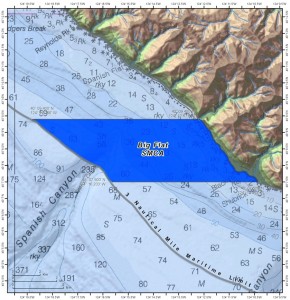
Big Flat State Marine Conservation Area
No take except for the recreational take of salmon by trolling and Dungeness crab by trap, hoop net or hand; or commercial take of salmon with troll fishing gear and Dungeness crab by trap. Includes exemptions for some federal tribes.
40° 09.400' N. / 124° 12.671' W.
40° 09.400' N. / 124° 19.366' W.
then south along the 3nm boundary
40° 07.500' N. / 124° 16.203' W.
40° 07.500' N. / 124° 10.313' W.
Double Cone Rock SMCA
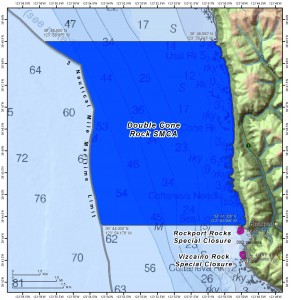
Double Cone Creek State Marine Conservation Area
No take except for the recreational take of salmon by trolling and Dungeness crab by trap, hoop net or hand; or commercial take of salmon with troll fishing gear and Dungeness crab by trap. Includes exemptions for some federal tribes.
39° 48.500' N. / 123° 50.713' W.
39° 48.500' N. / 123° 55.875' W.
then south along the 3nm boundary
39° 44.300' N. / 123° 54.178' W.
39° 44.300' N. / 123° 50.055' W.
Rockport Rocks Special Closure
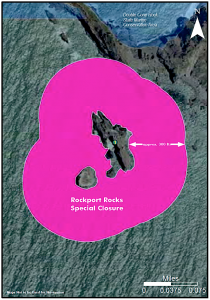
Rockport Rocks Special Closure
Special restrictions on boating and access due to sea bird rookery or marine mammal haul-out site
No vessel shall be operated or anchored from the mean high tide line to a distance of 300 ft seaward from the shoreline of the Rockport Rocks (in the vicinity of 39° 44.184' N. lat. 123° 50.020' W.) from March 1 to August 31
Vizcaino Rock Special Closure
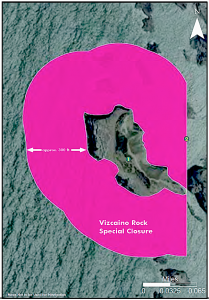
Vizcaino Rocks Special Closure<\strong>
Special restrictions on boating and access due to sea bird rookery or marine mammal haul-out site
No vessel shall be operated or anchored from the mean high tide line to a distance of 300 ft seaward from the shoreline of the Vizcaino Rocks, and seaward of the mean lower low tideline (in the vicinity of 39° 43.618' N. / 123° 49.950' W) from March 1 to August 31.
Ten Mile SMR

Ten Mile State Marine Reserve
Closed-no take of living marine resources is allowed.
39° 35.900' N. 123° 47.243' W.
39° 35.900' N. 123° 51.479' W.
then south along the 3nm boundary
39° 33.300' N. 123° 50.559' W.
39° 33.300' N. 123° 46.015' W.
Ten Mile Beach SMCA
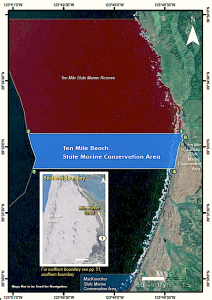
Ten Mile Beach State Marine Conservation Area
The only take allowed is the recreational take of Dungeness crab by trap, hoop net or hand; or commercial take of Dungeness crab by trap. Includes exemptions for some federal tribes.
39° 33.300' N. \ 123° 46.015' W.
39° 33.300' N. \ 123° 50.559' W.
then south along the 3nm boundary
39° 32.500' N. \ 123° 50.418' W.
39° 32.500' N. \ 123° 46.227' W.
then northward along the mean high tide line onshore to
39° 33.098' N. \ 123° 46.003' W.
39° 33.199' N. lat. 123° 45.966' W.
Ten Mile Estuary SMCA
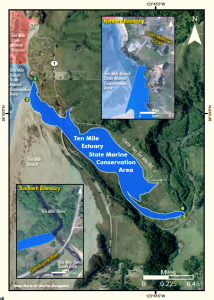 Ten Mile Estuary State Marine Conservation Area
Ten Mile Estuary State Marine Conservation Area
This area is closed, with exemptions for some tribes.
Includes waters below the mean high tide line the estuary, eastward of a line connecting the following two points:
39° 33.199' N \ 123° 45.966' W
39° 33.098' N \ 123° 46.003' W
And westward of a line connecting the following two points:
39° 32.400' N \123° 44.785' W
39° 32.382' N \ 123° 44.769' W
MacKerricher SMCA
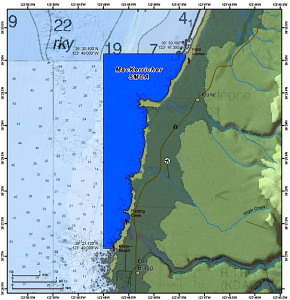
MacKerricher State Marine Conservation Area
All take is allowed, EXCEPT the commercial take of bull kelp (Nereocystis luetkeana) and giant kelp (Macrocystis pyrifera) is prohibited
39° 30.100' N \123° 47.390' W
39° 30.100' N \ 123° 49.000' W
39° 27.120' N \ 123° 49.000' W
39° 27.120' N \ 123° 48.830' W
Point Cabrillo SMR
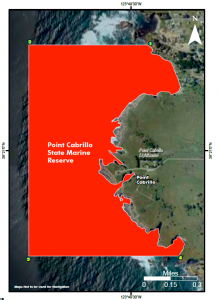
Point Cabrillo State Marine Reserve
Closed-No take is allowed.
39° 21.400' N \ 123° 49.418' W
39° 21.400' N \ 123° 50.000' W
39° 20.600' N \ 123° 50.000' W
39° 20.600' N \ 123° 49.266' W
Russian Gulch SMCA
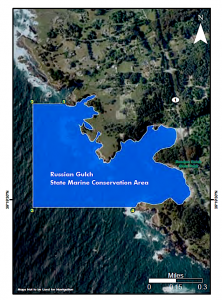
Russian Gulch State Marine Reserve
All take is allowed, EXCEPT the commercial take of bull kelp (Nereocystis luetkeana) and giant kelp (Macrocystis pyrifera) is prohibited.
This area is bounded by the mean high tide line and straight lines connecting the following points.
39° 19.860' N 123° 48.840' W
39° 19.860' N 123° 49.000' W
39° 19.470' N 123° 49.000' W
39° 19.470' N 123° 48.500' W
Big River Estuary SMCA
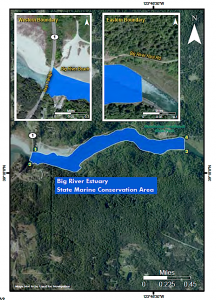
Big River Estuary State Marine Conservation Area
All take is prohibited, EXCEPT the recreational take of surfperch (family Embiotocidae) by hook and line from shore only; and Dungeness crab by hoop net or hand is allowed.
Waters below the mean high tide line within the Big River Estuary, eastward of:
39° 18.134' N \ 123° 47.517' W
39° 18.079' N \ 123° 47.540' W
And westward of :
39° 18.222' N \ 123° 46.242' W
39° 18.150' N \ 123° 46.240' W
Van Damme SMCA
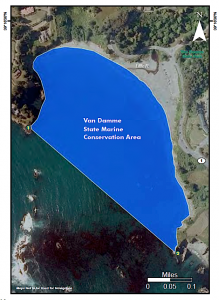
Van Damme State Marine Conservation Area
All take is allowed, EXCEPT the commercial take of bull kelp (Nereocystis luetkeana) and giant kelp (Macrocystis pyrifera) is prohibited.
This area is bounded by the mean high tide line and a straight line connecting:
39° 16.335' N \ 123° 47.712' W
39° 16.147' N \ 123° 47.429' W
Navarro River Estuary SMCA
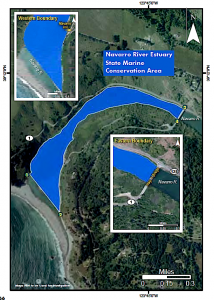
Navarro River Estuary State Marine Conservation Area
Waters below the mean high tide line within the estuary, eastward of a line connecting:
39° 11.575' N \ 123° 45.653' W
39° 11.415' N \ 123° 45.487' W
And westward of a line connecting:
39° 11.849' N \ 123° 44.808' W
39° 11.807' N \ 123° 44.842' W
Point Arena SMR
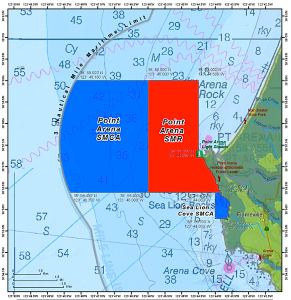
Point Arena State Marine Reserve
No take is allowed.
38° 57.35' N \ 123° 44.50' W
38° 59.00' N \ 123° 44.50' W
38° 59.00' N \ 123° 46.00' W
38° 56.40' N \ 123° 46.00' W
38° 56.40' N \ 123° 43.82' W
Point Arean SMCA

Point Arena State Marine Conservation Area
No take is allowed EXCEPT the recreational take of salmon by trolling and the commercial take of salmon with troll fishing gear.
This area is bounded by straight lines connecting the following points in the order:
38° 59.00' N \ 123° 46.00' W
38° 59.00' N \ 123° 48.16' W
then southward along the three nautical mile offshore boundary to
38° 56.40' N \ 123° 48.35' W
38° 56.40' N \ 123° 46.00' W and
38° 59.00' N \ 123° 46.00' W
Sea Lion Cove SMCA
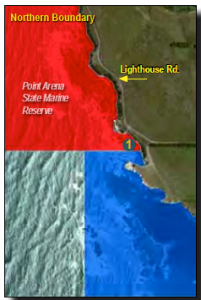
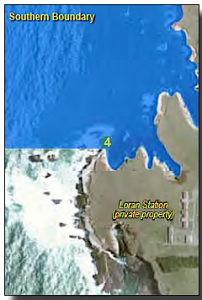
Sea Lion Cove State Marine Conservation Area
Take is allowed EXCEPT for the recreational and commercial take of all marine invertebrates and marine aquatic plants.
Bound by the mean high tide line and straight lines connecting the following points in the order listed:
38° 56.40' N 123° 43.82' W
38° 56.40' N 123° 44.00' W
38° 55.79' N 123° 44.00' W
38° 55.79' N 123° 43.74' W
Saunders Reef SMCA
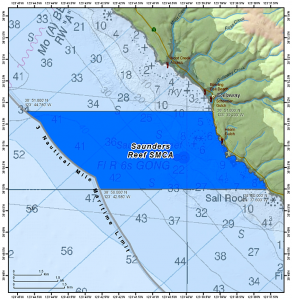
Saunders Reef State Marine Conservation Area
Take is prohibited EXCEPT for the recreational take of salmon by trolling, the commercial take of salmon with troll fishing gear, and commercial take of urchin.
Bounded by the mean high tide line and straight lines connecting the following points :
38° 51.80' N \ 123° 39.23' W
38° 51.80' N \ 123° 44.78' W
then southward along the three nautical mile offshore boundary to
38° 50.00' N \ 123° 42.58' W
38° 50.00' N \ 123° 37.60' W

The Ocean Protection Council, in collaboration with the California Ocean Science Trust and UC Sea Grant, is now embarking on 3 years of scientific data collection in our region to establish baseline conditions inside the new MPAs. Check out the projects currently underway.
As this science develops, the Noyo Center will bring it to you through talks, workshops, and other events. If you are interested in research partnerships contributing to MPA management and our dynamic connection with the oceans, please contact us.








 Ten Mile Estuary State Marine Conservation Area
Ten Mile Estuary State Marine Conservation Area 








